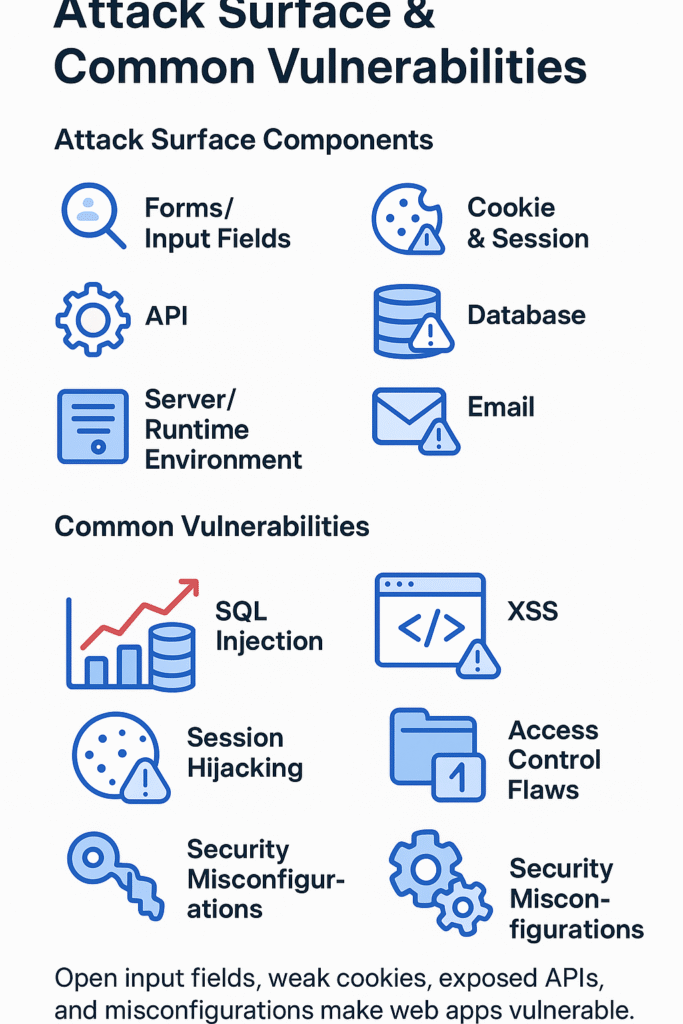
Nobody wants to think their web application is a security risk, but most have more holes than a screen door in July. Our security audits catch it all , forgotten APIs nobody’s watching, outdated login pages begging for trouble, and input fields that’ll swallow anything thrown at them.
We see it in every training session: developers swearing their apps are secure until we show them the unlocked doors they never knew existed.
Key Takeaways
- Think of your app like a house – every window, door, and vent is a potential entry point (APIs, forms, cookies, scripts)
- Attackers love going after the usual suspects: injection holes, cross-site scripting gaps, broken access rules
- You can’t secure what you don’t see – map it, rank the risks, lock it down, and keep watching
What’s Actually Part of the Attack Surface?

The attack surface isn’t some abstract concept – it’s every single spot where someone might try to break in. At our bootcamp, we’ve seen firsthand how these entry points pile up: user interfaces that accept data, APIs passing information back and forth, databases storing sensitive stuff, and even those forgotten email notification systems.
Nobody likes extra paperwork, but security controls matter here. Sure, things like authentication, data checks, and encryption make apps more complex. But here’s what we’ve learned from years of training developers – skipping these safeguards is like leaving your front door wide open. Each control needs care though, since poorly implemented security can actually create new problems.
Components Define the Web Application Attack Surface
Security threats lurk in every corner of web applications, and they’re getting craftier by the day. Here’s what keeps developers on their toes:
Forms and input fields sit there like open doors – search boxes, login screens, even those innocent-looking comment sections. Just last week, our bootcamp students discovered how a basic contact form turned into an SQL injection playground.
The way apps handle sessions through cookies and headers isn’t any safer. We’ve dealt with numerous cases where sloppy cookie settings led to account takeovers. These attacks happen way more often than anyone likes to admit.
Here’s where attackers usually strike:
- APIs that expose more than they should (we’ve seen API keys sitting in public repos for months)[1]
- Databases with customer info just waiting to be breached
- Runtime environments that nobody checks until it’s too late
- Email systems that turn into phishing highways
The scariest part? Most developers don’t spot these vulnerabilities until something goes wrong. Our training sessions always circle back to real cases – like when a client’s unencrypted backup ended up in the wrong hands, or when a missing email validator led to a company-wide breach. These aren’t just theoretical threats. They’re the kind of problems we tackle every day in our secure development courses.
Common Vulnerabilities Targeting the Web Application Attack Surface

SQL injection’s still got developers sweating, and with good reason. In our training sessions last week, students watched in horror as a single quote mark in a search box spilled their entire database onto the screen. These attacks aren’t complicated – they just need one tired developer to skip input checking. We’ve seen production systems fall to tricks that have been around since the early 2000s.[2]
The worst offenders in XSS attacks:
- Unescaped user input in comment sections
- Forum posts that accept HTML
- Search results that reflect raw queries
- Dynamic JavaScript that trusts user data
Nothing beats watching a client’s face when we show them their “unbreakable” login form getting cracked. Rate limiting and password requirements aren’t exactly new concepts, but somehow they keep slipping through the cracks. Our incident response team dealt with three session hijacking cases last month alone – all because of exposed tokens and weak cookie settings.
Access control slip-ups happen in the weirdest places:
- Directory traversal in file downloads
- User IDs exposed in URLs
- API endpoints missing authorization checks
- Admin functions protected by obscurity
Default passwords still hanging around in production? Found ’em. Debug modes accidentally left on? See those too. Security misconfigs are like collecting trading cards – our auditors never know what they’ll find next. Just yesterday, we spotted an admin panel wide open to the internet because someone forgot to update the .htaccess file.
Encryption feels like a broken record, but people still don’t get it. One client’s “internal” customer database showed up in Google searches – three years of records just sitting there. When we showed them the cached pages, you could hear a pin drop in the meeting room.
Third-party dependencies are a whole other headache. A startup we advised got hammered when their analytics provider turned into a crypto mining operation overnight. Their users’ CPU usage spiked, and support tickets flooded in before they even knew what hit them. These days, external scripts need as much vetting as internal code – maybe more.
Map, Analyze, and Minimize the Web Application Attack Surface

Identification and Cataloging of All Entry Points
The first step is to identify every interface, internal and external. This includes not just the obvious login page or API endpoints, but also hidden admin panels and test endpoints. Our team uses asset discovery tools to maintain a living inventory.
Grouping and Prioritization Based on Risk and Accessibility
Not all entry points are equally dangerous. We prioritize those accessible without authentication or those with high privileges. This focus helps allocate limited resources efficiently.
Utilization of Security Tools for Detection and Prevention
Security scanners, application firewalls, and attack surface analysis tools help detect exposed endpoints and vulnerabilities before attackers do. They help detect exposed endpoints and vulnerabilities before attackers do. We rely heavily on these tools but also know their limits, manual code reviews and threat modeling remain key.
Implementation of Secure Coding and Access Controls
Secure coding practices such as strict input validation, output encoding, and enforcing the principle of least privilege are essential. Pairing these habits with proven attack surface reduction techniques helps shrink exposure even further. We’ve found that even small changes in privilege assignments can dramatically shrink the attack surface.
Additional Factors Influence Web Application Attack Surface Management
Credit: PNSQC
Continuous Monitoring and Incident Response Integration
Attack surfaces aren’t static, which is attack surface reduction best practices alongside continuous monitoring to catch anomalies early. Our security teams integrate monitoring with incident response so that when something suspicious pops up, we can act fast.
Third-Party Component Risk Assessment and Management
Third-party scripts and libraries are part of the attack surface too. Assessing these components for vulnerabilities and keeping them updated is a must. We’ve seen projects where outdated third-party code introduced critical risks.
User Education and Awareness Impact on Attack Surface
Humans are often the weakest link. Training users to recognize phishing and social engineering reduces risk. We regularly include user awareness as part of our security programs.
Emerging Technologies and Their Effect on Attack Surface
Cloud services, microservices, and containerization have expanded attack surfaces. We’ve learned to protect ourselves by locking down our containers and using cloud-native security tricks. But the truth is, the ground keeps shifting. New tools, new risks, new ways for attackers to poke around, it never stops changing.
Conclusion
Web apps are like houses with too many doors, and attackers only need to find one unlocked. We’ve watched clients scramble after breaches because they never bothered checking all their entry points. Every API, form field, and file upload is a potential weak spot.
Sure, perfect security doesn’t exist. But making attackers work harder? That’s doable. Map out those entry points, patch the obvious holes, and keep watching. Those midnight security alerts might be annoying, but they beat explaining to customers why their data’s for sale online.
Join our Secure Coding Bootcamp and learn how to lock down your digital doors before someone else walks in.
FAQ
What is a web application attack surface and how do attack vectors, entry points, and vulnerabilities fit together?
The web application attack surface is the total set of entry points an attacker could try. These include APIs, user interface security gaps, authentication entry points, and admin interfaces. Attack vectors like injection attacks, cross-site scripting, or broken access control take advantage of these weak spots. When security misconfigurations or data exposure exist, the attack surface grows. Entry points can be internal-facing interfaces, external-facing interfaces, or even search functions and data entry forms. Knowing how vulnerabilities connect with attack vectors is key to reducing risk and managing overall security.
How does attack surface management help with injection attacks, cross-site request forgery, and session hijacking?
Attack surface management is about finding and tracking weaknesses across a system. It helps uncover injection attacks, cross-site request forgery, and session hijacking before attackers strike. By checking input fields, transactional APIs, and operational commands, teams can spot authentication vulnerabilities, session management flaws, and cookie security issues. Monitoring interfaces and privilege escalation paths matter too. Attack surface mapping, analysis, and metrics guide planning. Pairing security scanning, vulnerability assessment, penetration testing, and bug bounty programs builds stronger defense. This approach also supports timely security patches and better secure coding practices.
What role do access control, user privileges, and authorization play in preventing broken access control or privilege escalation?
Access control, user privileges, and authorization work together to block broken access control. Without them, attackers can steal sensitive data or escalate privileges. Strong database security and resource connection security help protect cryptographic keys, session tokens, and sensitive data. Activity logging and access auditing track who does what. Threat modeling during design highlights weak entry/exit points. Encryption, secure coding practices, and runtime environment checks add safety. Careful control of user privileges and clear authorization rules shrink the attack surface and stop intrusions before they spread.
Why do cloud native applications, microservices security, and dynamic attack surface issues make security harder?
Cloud native applications and microservices security add many moving parts. Each service, whether static attack surface or dynamic attack surface, creates new application vulnerabilities. APIs, monitoring interfaces, and data entry forms open more entry points for threat actors. Supply chain attacks and server-side request forgery are real dangers here. Network security and endpoint security must protect both external-facing interfaces and internal-facing interfaces. Session tokens, input validation, and encryption are vital for sensitive data protection. Because attack surface expansion happens fast, ongoing attack surface analysis, scanning, and security patches are needed.
How do cybersecurity programs reduce risk from phishing attacks, malware vectors, and zero-day exploits?
Cybersecurity programs layer defenses together. Application firewalls stop network traffic interception and brute force attacks. Honeypots catch threat actors during the reconnaissance phase. Social engineering and phishing attacks target people, while malware vectors and zero-day exploits strike applications. Strong cookie security, session management, and secure coding practices guard against active content vulnerabilities and clickjacking. Encryption and data protection help limit harm from denial of service or data exposure. Cybersecurity programs also push attack surface reduction, endpoint security, and attack surface metrics. With steady vulnerability assessment, penetration testing, and activity logging, risks stay lower and threats are caught sooner.
References
- https://en.wikipedia.org/wiki/SQL_injection
- https://owasp.org/www-community/attacks/Session_hijacking_attack

